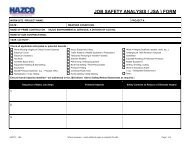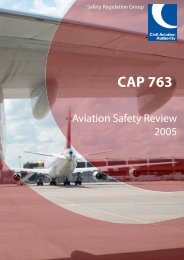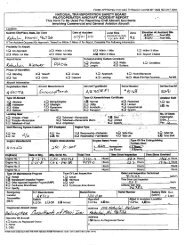International Helicopter Safety Team Safety Management System Toolkit
IHST - Safety Management Toolkit - Skybrary
IHST - Safety Management Toolkit - Skybrary
- No tags were found...
You also want an ePaper? Increase the reach of your titles
YUMPU automatically turns print PDFs into web optimized ePapers that Google loves.
employee is essential to making the process effective.<br />
A non-punitive disciplinary policy demonstrates<br />
management's commitment to achieving the organization's<br />
safety goals.<br />
When producing an occurrence or hazard<br />
report, every effort should be made to ensure the<br />
form is easy to understand and user friendly. The<br />
organization should strive to make all reporting<br />
forms compatible for each area of the operation.<br />
This will facilitate data sharing, trend analysis and<br />
will also make the occurrence or hazard investigation<br />
process easier.<br />
Depending on the size of the organization, the<br />
most expedient data collection method might be to<br />
utilize existing paperwork, such as flight and maintenance<br />
reports. The use of hand written reports or the<br />
information derived from verbal reports is equally<br />
acceptable. However, verbal accounts should always<br />
be followed-up with a written report.<br />
An organization’s safety reporting<br />
system should encompass the following<br />
fundamental elements:<br />
<strong>System</strong>s for reporting hazards, events or<br />
safety concerns<br />
<strong>System</strong>s for analyzing data, safety reports and<br />
other safety related information<br />
Methods for the collection, storage and distribution<br />
of data<br />
Corrective action and risk reduction strategies<br />
On-going monitoring<br />
Confirmation of the effectiveness of<br />
corrective action<br />
Not just flight operations:<br />
Maintenance errors are known to be a significant<br />
cause of aviation accidents. If maintenance had not<br />
formed one of the links in a chain of events, an accident<br />
might not have occurred. These links are often<br />
simple errors that, when combined with other factors,<br />
might result in catastrophe. For example, low air pressure<br />
in just one tire can result in major damage or<br />
destruction of an aircraft, serious injury or death to<br />
hundreds of people and the failure of an airline.<br />
Courtesy of Gordon Dupont, CEO, <strong>System</strong> <strong>Safety</strong> Services Inc.<br />
One of the problems is that maintenance personnel<br />
are sometimes not the best communicators.<br />
They live with and work around known hazards<br />
until an accident occurs.<br />
In order for a <strong>Safety</strong> <strong>Management</strong> <strong>System</strong> to work,<br />
maintenance must report hazards with a potential to<br />
cause an accident, because the “little things have the<br />
potential to become big things (accidents).” In order<br />
to reduce human error to “As Low As Reasonably<br />
Practical” (or ALARP), everyone must do their part to<br />
report the little things that have the potential to<br />
become big things. This can be accomplished by:<br />
Reporting things pertaining to facilities, equipment or<br />
procedures that interfere with doing the job safely.<br />
Reporting human errors or near misses that would<br />
enable safety nets to be developed to prevent a<br />
future occurrence.<br />
Maintenance technicians have the duty and responsibility<br />
to report anything having the potential to<br />
become a hazard so that a risk analysis can be made.<br />
SMS <strong>Toolkit</strong> 55







